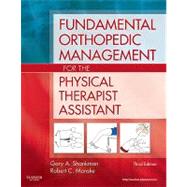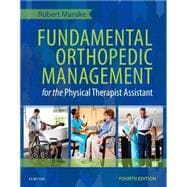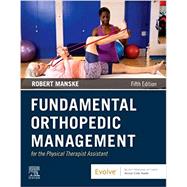Fundamental Orthopedic Management for the Physical Therapist Assistant

Fundamental Orthopedic Management for the Physical Therapist Assistant
- ISBN 13:
9780323056694
- ISBN 10:
0323056695
- Edition: 3rd
- Format: Paperback
- Copyright: 10/01/2010
- Publisher: Mosby Inc
- Newer Edition
Rent
Sorry, this item is currently unavailable on Knetbooks.com
Note: Supplemental materials are not guaranteed with Rental or Used book purchases.
Extend or Purchase Your Rental at Any Time
Need to keep your rental past your due date? At any time before your due date you can extend or purchase your rental through your account.
Summary
Designed to meet the unique needs of physical therapist assistants, Fundamental Orthopedic Management for the Physical Therapist Assistant, 3rd Edition focuses on critical thinking and helps you apply fundamental orthopedic principles in physical therapy interventions. Clear explanations cover basic concepts such as the PTA's role in physical assessment of flexibility, strength, endurance, and balance, along with the specifics of tissue healing; medications; gait and joint mobilization; and an introduction to biomechanics. It also describes the application of therapeutic interventions for many orthopedic conditions by region and affliction. Edited by two experienced clinicians, Gary A. Shankman and Robert C. Manske, and written by contributors who are experts in their respective fields, this is your one-stop source for PTA practice in orthopedics. Clear explanations of difficult concepts are provided by experienced, practicing clinicians who address the specific needs of the PTA. Comprehensive coverage provides a "one-stop" source for all things orthopedic, from core concepts related to orthopedics to information about the PTA's role in physical assessment and interventions, in-depth reviews of types of tissue healing, biomechanics, and pharmacology. A focus on critical thinking and application helps to prepare you for the treatment room and for the clinical practicum portions of the curriculum. Key terms and learning objectives begin each chapter, useful as "checkpoints" to which you can refer to ensure content comprehension and study effectively for examinations. Over 500 illustrations reinforce concepts and procedures, supplemented by summary tables and boxes. End-of-chapter review questions prepare you for the types of critical thinking you will be required to do in practice. Unique! End-of-chapter glossaries define key terms. Appendices provide a quick reference for information such as laboratory values, common medications, and associated movements. A six-part structure organizes the book's material: Part I: Basic Concepts of Orthopedic Management begins with the essential concepts of teamwork and shared responsibility within the physical therapy team and then covers the basic areas of flexibility, strength, endurance, balance, and coordination. Part II: Review of Tissue Healing introduces the types of tissue, then discusses ligament, bone, cartilage, muscle and tendon healing before looking briefly at neurovascular healing and thromboembolic disease. Part III: Common Medications in Orthopedics focuses on common medications used in orthopedics, their actions, side effects, and possible impact on treatment. Part IV: Mobilization and Biomechanics deals with the basics of human movement including a chapter on gait, and provides information on joint mobilization. Part V: Management of Orthopedic Conditions by Region covers the body from the ankle, foot, and toes up to the shoulder, the elbow, and the wrist and hand, including a chapter on the spine. NEW! Part VI: Management of Orthopedic Conditions by Affliction includes chapters on hot topics such as rheumatic disease; pain and pain-related syndromes; and bracing, orthotics, and prosthetics. Student resources on a companion Evolve website include critical thinking applications, review questions, animations, reference lists from the book linked to MedLine, and more.More than 30 new contributors participated in this new edition, allowing you to learn from experts in eac










